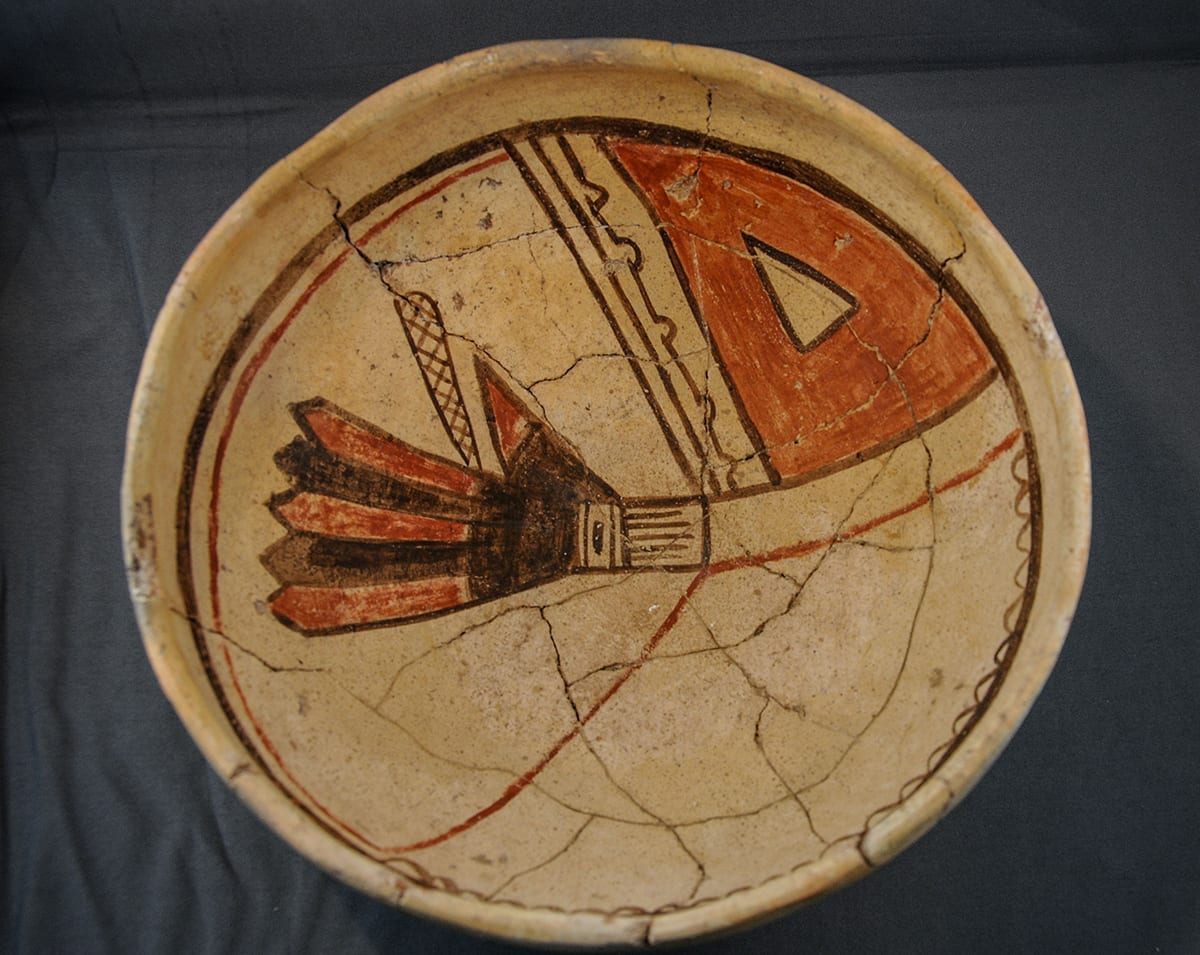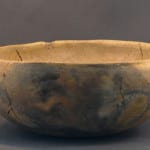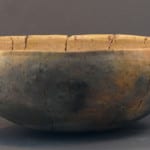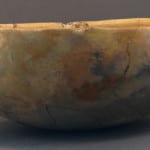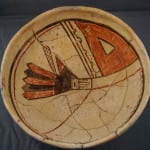Between about 1475 CE and 1680 CE the Zuni people produced “Matsaki” pottery, including this bowl.
This pottery type was roughly contemporaneous with monochromatic Hopi Jeddito ware (see 1994-15 and 1997-05 in this collection) and is generally categorized as derived from Jeddito’s polychromatic variation, Sikyatki ware (see shards 2012-11a & b). Since a relatively intact Sikyatki bowl is beyond the means of this collection, this Matsaki bowl is about as close as I will get.
Bowl 2012-22 is somewhat deep with a slightly incurved rim and internal lip. Judging from the clay revealed by chipping, the body is formed from rather rough-textured clay mixed with larger pieces of pinkish temper.
I believe the inside surface has been slipped with a somewhat smoother slip that may have also been applied to the exterior. I’m just not sure.
The exterior of the bowl is undecorated. About an inch below the interior rim, a single thick black line encircles the bowl. The interior of the bowl is dominated by a dart-shaped element with a short, decorated shaft. From one corner of the shaft emerge two red lines that spread out until they touch or come close to touching the black framing line. From the other corner of the shaft emerge two black lines that also spread out to touch the framing line. The result is to divide most of the interior surface of the bowl into three wedge-shaped segments. One segment lacks interior design except for a series of small lobes drawn on the lower side of the framing line. The second segment contains the polychromatic “dart image.” The final segment is dominated by a thick red triangle (with an unpainted triangular center) and three lines—one of them with u-shaped indentions. The first segment covers about 36% of the bowls interior, the second about 37% and the final segment about 21% The remaining few percent of area are accounted for by the width of the “dart” shaft.
I do not understand the iconography of this bowl beyond the general comment that the dart-shaped element seems to represent a collection of feathers and I assume that such feathers are related to prayers for blessings, particularly rain. The Cooke Collection (Wade and Cooke, 2012:64-65) contains a Sikyatki bowl with a similar element which Ed Wade interprets as a “tiponi, surmounted by prayer feathers (which) represents the accumulated presence and prayers of a clan.” It is my understanding that tiponi are particular prayer feather bundles that are often attached to the top of a ladder providing entrance to an underground kiva and indicating that the clan leaders are in residence and doing sacred work. Translated into Anglo culture, the tiponi are similar to the family crest of a Scottish clan.
Alfred Dittert, Jr and Fred Plog explain the origin of Matsaki pottery:
“Interesting…in retrospect is the case of Matsaki Polychrome in the Zuni area. Zuni legends indicate the movement of some Zunit to Hopi lands…Abandonmernt of glaze pint and the adoption of a distinctively different style were both evident in Matsaki Polychrome from 1475 to late in the 1600s. [About the date of the Pueblo Revolt against the Spanish.] The snmooth hard surface of previous ceramics gave way to a somewhat rough or crazed surface over a crumbly paste. A background color of bluff to orange, cream or yellow-brown was decorated in complex geometric and feather designs using a dark brown or black and a reddish-brown paint. The styles resemble those of Sikyatki Polychrome of the Hopi region, but the brushwork was of poorer quality. Bowl interiors were the primary field utalized, and only simple elements appeared on the bowl exteriors (1980:122-123).”
Bowl 2012-22 seems to well fit Dittert and Plog’s description of Matsaki Polychrome.

